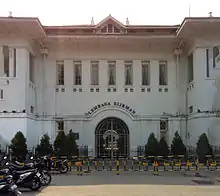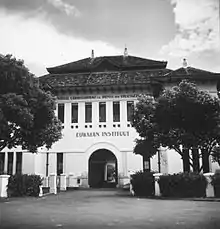Eijkman Institute for Molecular Biology
The Eijkman Institute for Molecular Biology is a laboratory in Jakarta, Indonesia. It is most known for the discovery by Christiaan Eijkman that Beriberi was caused by a lack of thiamine in the human body.


History
Founded as the Geneeskundig Laboratorium, or Medical Laboratory, at Jalan Diponegoro No. 69 in Central Jakarta in 1888, Christiaan Eijkman was stationed there as its first director. During his time there, he discovered that Beriberi, which was commonly believed to be caused by external forces, was caused by a lack of thiamine in the human body. This led to a Nobel Prize for Physiology or Medicine for Eijkman in 1929. In 1938, the laboratory was renamed the Eijkman Institute in honor of Eijkman.[1][2]
During World War II, Japanese occupiers accused the center's first Indonesian director, Achmad Mochtar, of poisoning a batch of vaccine that was to be delivered to slave laborers. After Mochtar and his researchers were tortured and interrogated, he made a deal with the Japanese that he would plead guilty if his researchers were released. He was then executed and buried in an unmarked grave.[1] It is possible that Mochtar was a scapegoat for a failed Japanese experiment designed to validate a conjured tetanus toxoid vaccine for their troops.[3]
During the 1960s, the institute closed due to upheaval in the country and was absorbed into the Cipto Mangunkusomo Hospital. It remained closed for the next thirty years until 1992, when B.J. Habibie, the Minister of Research and Technology, decided to reopen the institute. By 1993, it was fully operational, but ran into further troubles in 1998 due to the Asian financial crisis.[1][2]
In 2004, the institute identified the suicide bomber who blew himself up in front of the Australian Embassy, which drew recognition to the practical benefits of molecular biology. Today, the institute houses one of the few Biosafety Level 3 laboratories in the country, which is equipped with a gas decontamination chamber.[1]
Building
From the outside, the building has been described as looking like a museum, although the inside has not been renovated in an attempt to keep the building looking as it did when Eijkman was working there. This includes a visitor's lounge which is still furnished with wood and rattan chairs and other furnishings that have not been changed since the opening of the building.[1]
References
- Saptura, Antonny (4 September 2012). "Jakarta: The Eijkman Institute". Jakarta Globe. Retrieved 2 September 2014.
- "History". Eijkman Institute. Retrieved 6 September 2014.
- Kevin Baird, "War Crimes in Japan-Occupied Indonesia: Unraveling the Persecution of Achmad Mochtar", The Asia-Pacific Journal, Vol. 14, Issue 1, No. 3, January 1, 2016.